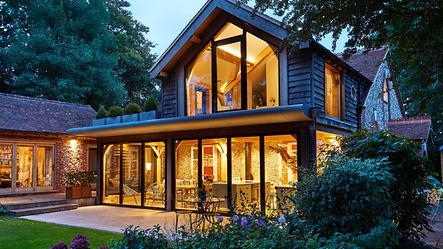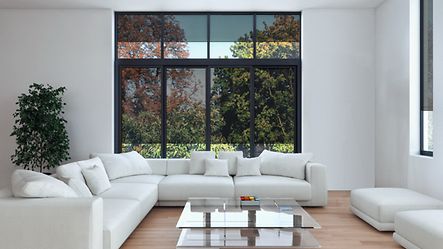What are U-values and what do they mean for doors and windows?
If you are building your own home, adding an extension, or refurbishing your house, you may have heard the term U-values being used in relation to energy efficiency. In this blog we outline what U-values are and what they mean for your doors and windows.

Manage your expectations, and choose the right products
U-values are a measure of the thermal resistance of a building element, like a door or window. They indicate the rate of thermal transmittance through the material layers of an element, in the case of U-values, the slower this is, the better.
The lower the U-value, the more effective a component is as an insulator and the more energy efficient it is. Building regulations stipulate acceptable U-values for different building elements. As regulations tighten to improve energy performance and reduce the operational costs of buildings, U-value requirements will get smaller.
Recently, changes to building regulations saw U-value requirements for windows and doors with more than a 60% internal face glazed reduce from 1.6 W/m²K to 1.2 W/m²K – that is watts per square metre per Kelvin. This is for new dwellings. For existing buildings, replacement windows should now have a U-value of 1.4 W/m²K.
Choosing the right windows and doors goes a long way to making your home as efficient as possible so you can be comfortable year-round and minimise your energy bill.
This homeowner had a near fully-glazed extension to make the most of stunning countryside views using Schüco windows and bi-fold doors, and has saved money on her bills. She said: “I’ve been surprised by how much the heating demand has gone down. Although the house has doubled in size the energy bills have almost halved.”


Choosing doors and windows with low U-values
For windows and glazed doors, there are two key things that make up the overall U-value: the Ug value and Uf value. A Ug value indicates how insulating the glass is as a component of a door or window. A Uf value is a measure of how insulating the frame is. Combined, Ug and Uf values create a Uw value – the overall value for the window or door.
The type of glass you use is a hugely influential factor in determining a door or window’s final U-value and therefore its ability to insulate. For example, choosing triple glazing over double glazing will significantly reduce a window or door’s overall U-value. If you have some money spare in your budget and top-notch energy performance is your priority, opting for a specialist high-performance insulating glass would further reduce U-values.
It's not all about the glass however, frames are also important. Roughly 30% of heat loss takes place through a window frame. Choosing premium systems with high-quality frames is key for achieving low U-values for the doors and windows in your home.
All Schüco doors and windows are backed by precision German engineering that helps ensure our frames are as airtight as possible to reduce heat loss. Our latest bi-fold door has been designed to achieve U-values are low as 1.0 W/m²K. Similarly, our near-frameless panoramic sliding door can achieve extraordinary U-values as low was 0.82 W/m²K.
We always prioritise performance and aesthetics. Our doors will look sleek, contemporary, and let plenty of natural light into your home, but the quality of their design will also ensure exemplary thermal performance.
U-values for Passivhaus
You’ve likely heard the term ‘Passivhaus’ by now. The building standard is becoming increasingly popular for those looking to construct the most efficient, low carbon homes. Achieving Passivhaus certification ensures a building maintains comfortable indoor temperatures with minimal energy use, primarily through superior insulation, airtight construction, and optimised ventilation.
To meet Passivhaus requirements, windows and glazed doors should have U-values of 0.8 W/m²K or less. We have a range of windows and doors that have been certified by the Passivhaus Institute. These products have been shown to meet strict requirements, being proven to contribute substantially to increasing the energy efficiency of buildings.
Passivhaus certification may not be possible for every home, but you can still achieve excellent energy performance with the right products. Our ASE 80 HI sliding door, for example, can achieve a U-value of 0.9 W/m²K, far lower than what is required in current building regulations.
These doors feature in this impressive, eco-friendly home that was built to meet Passivhaus standards using our HI (highly insulated) and SI (super insulated) product range.

Get in touch with us or your local Schüco partner to discuss how you can achieve low window and door U-values to create a comfortable and economical home.